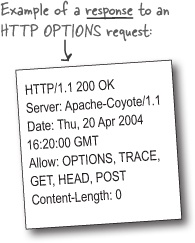If you’re preparing for the exam, you should be able to recognize all of them from a list, and have at least the briefest idea of what they’re used for. But don’t spend much time here!
Note
In the real servlet world, you care about GET and POST.
In the exam world, you care just a tiny bit about the other HTTP Methods as well.
GET | Asks to get the thing (resource / file) at the requested URL. |
POST | Asks the server to accept the body info attached to the request, and give it to the thing at the requested URL It’s like a fat GET... a GET with extra info sent with the request. |
HEAD | Asks for only the header part of whatever a GET would return. So it’s just like GET, but with no body in the response. Gives you info about the requested URL without actually getting back the real thing. |
TRACE | Asks for a loopback of the request message, so that the client can see what’s being received on the other end, for testing or troubleshooting. |
PUT | Says to put the enclosed info (the body) at the requested URL. |
DELETE | Says to delete the thing (resource / file) at the requested URL. |
OPTIONS | Asks for a list of the HTTP methods to which the thing at the requested URL can respond. |
CONNECT | Says to connect for the purposes of tunneling. |
Get Head First Servlets and JSP, 2nd Edition now with the O’Reilly learning platform.
O’Reilly members experience books, live events, courses curated by job role, and more from O’Reilly and nearly 200 top publishers.



